In case your time is short
- Focus on Observability: Modern enterprise network performance monitoring has evolved to emphasize observability over traditional network monitoring. Observability offers deep visual and data-driven insights, allowing enterprises to react proactively to enhance stability and performance.
- Role of Visualization: Tools like LogicMonitor transform raw IT infrastructure data into visual formats that help users understand complex system behaviors over time, supporting rapid integration and comprehensive monitoring.
- Beyond Real-Time Monitoring: Observability goes beyond immediate issues to include historical data analysis, facilitating trend analysis, and strategic planning. This comprehensive view helps enterprises anticipate and mitigate future issues.
- Actionable Insights: Advanced monitoring tools analyze data to provide actionable insights, supporting informed decision-making and allowing preemptive issue resolution to avoid critical problems.
- Challenges in Monitoring: Common challenges include insufficient resource allocation for IT tasks, maintaining and configuring monitoring tools, shifting from reactive to proactive management, and setting effective dashboards and alert thresholds.
- INOC's Approach: We utilize a multi-layered ITIL framework integrating observability with traditional ITSM principles. This approach includes incident management, problem management, capacity management, and change management to optimize network performance and anticipate future needs.
- Strategic Advice for Enterprises: When helping enterprise teams with performance monitoring, we encourage stepping back to define the IT environment's purpose, identifying the critical components needed to serve that purpose, assessing monitoring tools to make sure their tooling is capable, establishing relevant metrics, and continually adjusting those strategies and tools to stay aligned with business and technology developments.
This guide explores the crucial distinctions and overlapping performance and network monitoring roles within enterprise IT.
As we dive into insights we’ve gleaned from decades of experience supporting network operations in enterprise organizations, we focus on how the advanced observability of IT systems goes beyond traditional network monitoring by offering deep visual and data-driven insights.
These capabilities allow enterprises to not only react to real-time and historical data but also to make proactive adjustments that enhance overall performance and stability.
Disarticulating “Performance Monitoring” From “Network Monitoring”
Performance monitoring in an enterprise context often centers on the concept of "observability," which differs slightly from general network monitoring.
Observability focuses on visualizing metrics and data from IT infrastructure in meaningful ways that drive decision-making. Performance monitoring extends beyond basic monitoring tasks, such as generating alarms and alerts, to include graphical representations of data like charts and graphs, which help understand trends, network top talkers, and overall infrastructure performance. This kind of monitoring gathers data points over time and transforms them into insightful visualizations for actionable intelligence.
Let’s break this down a bit further:
Visualization of Metrics and Data
Observability platforms, such as LogicMonitor, play a crucial role in converting raw data from IT infrastructure into visual formats that are easy to interpret. This visualization capability enables IT teams to see beyond mere data points and understand complex system behaviors over time.
For example:
- LogicMonitor can automatically discover network devices across various brands, such as Cisco, Juniper, and Meraki. This allows for quick integration and monitoring setup, helping organizations rapidly achieve visibility across their network infrastructures.
- LogicMonitor provides detailed monitoring for various network elements such as firewalls, routers, switches, and SD-WAN solutions. It supports multiple protocols, including SNMP, API, jFlow, NetFlow, sFlow, and more, ensuring thorough coverage and visibility.
- The introduction of Datapoint Analysis in LogicMonitor's new UI offers deep analytical capabilities. It allows users to analyze and visualize data in depth, which facilitates informed decision-making and efficient problem resolution.
Graphical Representations
Unlike traditional network monitoring, which might only alert to a system's up/down status or basic performance thresholds, observability includes detailed graphical representations like charts and graphs. These visuals help identify trends, understand resource utilization patterns, and pinpoint the top network traffic sources.
(Actually) Actionable Insights
The ultimate goal of observability is to transform data into actual insights that inform decisions. This process involves not just collecting and monitoring data but analyzing it in useful ways to make informed decisions that can preempt potential issues. For example, observability can reveal a slowly developing problem before it becomes critical, enabling proactive interventions.
Beyond Real-Time Monitoring
While “network monitoring” often focuses on real-time data and immediate issues, observability encompasses both real-time and historical data analysis. This allows for trend analysis and long-term planning, providing a strategic advantage in IT management and the NOC, more specifically. Observability tools can aggregate data over extended periods, offering insights into seasonal impacts, long-term growth trends, or recurring issues that require structural changes in the network or applications.
In short, while network monitoring focuses on the operational status of network components (like routers, switches, and connections), checking for faults, failures, or inefficiencies, observability dives deeper into analyzing data collected from these and other IT systems.
We speak from experience when we say observability isn’t just a buzzword but has a strategic impact in its ability to inform decision-making at multiple levels of an organization. For instance, our clients often use observability data to justify investments in infrastructure upgrades or to tweak resource allocation to optimize performance.
Similarly, operational teams can adjust configurations, enhance security postures, or streamline workflows based on insights derived from observability tools.
Addressing the Challenges of Enterprise Network Performance Monitoring Today
As a NOC service provider supporting many enterprise organizations, we’re uniquely aware of the challenges they face in monitoring network performance.
Here’s a brief rundown of where we see teams struggle most these days.
1. Resource allocation
Many enterprises lack a dedicated IT staff focused on performance, problem, and capacity management. This often leads to issues that are only addressed once they have escalated to critical disruptions, which can be costly and damaging to business operations.
We often recommend these teams assess their current IT staffing and consider training existing staff to handle these specialized tasks or hiring additional personnel. For many businesses, particularly those without the scale to support such specialization, outsourcing to providers like INOC can naturally emerge as a more cost-effective and efficient solution and trigger the move to our platform.
If you're not familiar with our Ops 3.0 platform, INOC's VP of Technology, Jim Martin sums it up:
2. Tool maintenance and configuration
Enterprises also often struggle with the time and expertise required to maintain and configure monitoring tools properly. This includes setting appropriate performance thresholds and developing effective dashboards that can provide actionable insights.
We recommend (safely and competently) automating as many of these processes as possible. Modern monitoring tooling offers automated alerting, threshold adjustments based on machine learning, and pre-configured dashboards tailored to specific industry needs can significantly reduce the burden on IT staff. Yet, we consistently see these tools underused, even in surprisingly large environments.
3. Proactive vs. reactive management
Another more nebulous challenge is the entrenched reactive culture within IT departments, where the focus is on resolving issues as they occur rather than investing the resources and effort to prevent them.
Transitioning to a proactive management approach requires a shift in strategy and mindset. Typically, the best way to trigger that change is to measure the direct and indirect costs of downtime. Then, the resources required to get proactive can be pitched as a genuine investment whose value will exceed its costs.
As a brief aside, calculating the costs of downtime can be tricky, but here are some ways to measure it across several dimensions:
- Calculate Direct Losses: Quantify the immediate financial impact of downtime. This could include loss of sales, reduced productivity, and any costs incurred during the downtime to try and mitigate the impact (e.g., overtime labor, additional resource allocation). Metrics such as sales per hour can help quantify losses due to unavailable services.
- Estimate Recovery Costs: Significant resources are often needed to restore services and systems to normal after an outage. These costs may include technical support expenses, additional hardware or software costs, and the expense involved in identifying and rectifying the issue.
- Evaluate Impact on Customer Satisfaction and Retention: IT downtime can lead to poor user experience, loss of customer trust, and customer churn. Estimating the long-term financial impact of lost customers and the cost of acquiring new ones can be complex but crucial. Surveys and historical data on customer retention rates post-downtime incidents can provide valuable insights.
- Compliance and Legal Costs: Depending on the industry, downtime can result in breaches of legal or regulatory compliance, leading to fines, penalties, and legal costs. Understanding these potential costs is critical for industries like finance, healthcare, and public services.
- Opportunity Costs: Consider what strategic initiatives or innovations were delayed or shelved because resources had to be diverted to address or mitigate downtime.
Researchers have attempted to measure the costs and impact of downtime, too. An oft-cited 2014 Gartner report states the average cost of downtime to be $5,600 per minute. A 2016 report from Ponemon Institute calculates the average to nearly double that at $9,000 per minute. Of course, these are imperfect studies and simple averages relative to some factors like industry, revenue, etc. Still, those numbers are no laughing matter.
4. Dashboard and visualization effectiveness
Many enterprises don’t have effective single-pane-style dashboards that effectively communicate KPIs and critical alerts to relevant stakeholders.
We always stress the importance of developing dashboards that are not only informative but also actionable. This means including real-time data visualizations highlighting unusual activities, trends, and potential bottlenecks. Dashboards should be customizable to reflect the specific needs and priorities of different teams within the organization.
The slider below shows a sample of the reports and dashboards we maintain for all of our clients.

Change Metrics: These monitor changes made, categorizing them as service-affecting or non-service-affecting and breaking them down by time of day and day of the week.

NOC TTC (Time-to-Close): This calculates the average time it takes to close an incident after it has been resolved.

NOC TTN (Time-to-Notify) Compliance: This measures the time it takes for the service to notify about an issue.

TTA (Time-to-Acknowledge) Compliance: This measures how often a specific performance metric is met. In the example below, P1 TTA was met 100% of the time in May 2023.
📄 Read our other guides for a deeper dive into dashboarding and reporting in the NOC:
- NOC Service Level Reporting: Basics, Best Practices and Examples
- NOC Dashboards: Pursuing the "Single Pane of Glass"
5. Thresholds and alerting
This is one of the most pervasive problems we see in enterprises. Incorrectly set thresholds can lead to either an overwhelming number of irrelevant alerts (alert fatigue) or a dangerous lack of critical alerts (under-monitoring). A network monitoring system that generates too many insignificant alerts often causes IT staff to become desensitized to warnings, which leads to missing critical alerts.
INOC’s Approach to Performance Monitoring
We leverage a multi-layered ITIL framework to manage and optimize network performance for enterprise NOC support clients.
More specifically, we integrate traditional ITSM principles guided by ITIL with modern observability and performance monitoring techniques. This combination gives us a holistic approach to managing IT services and infrastructure.
Here are the core components of our methodology:
-
Incident Management: We use performance monitoring tools to detect and respond to incidents in real time. Our Ops 3.0 platform uses machine learning and automation (AIOps) in combination with a robust configuration management database (CMDB) to correlate alarm data and generate incidents at machine speed, ensuring immediate attention to potential disruptions.
-
Problem Management: Beyond addressing immediate incidents, our service strategy—again, in alignment with ITIL— includes identifying and analyzing recurring problems to prevent future incidents. This aspect of problem management involves analyzing data collected over time from various network components to pinpoint underlying issues that could lead to repeated system disruptions or degraded performance. The goal is to stop waiting for fires to start across a network by fire-proofing it.
-
Capacity Management: Through continuous monitoring and data analysis, we routinely assess the capacity needs of our clients’ IT infrastructures so resources are scaled appropriately to meet current and future demands without over-provisioning or resource wastage. We use performance data to forecast growth trends and prepare the infrastructure to handle increased load, thereby optimizing cost efficiency and performance.
-
Change Management: We also integrate performance monitoring insights into our change management processes. Thanks to the data captured in our CMDB, we can understand the impacts of potential changes on network performance and make informed decisions about implementing modifications. This careful consideration helps mitigate risks associated with changes and ensures that system stability and performance are maintained.
All of this distills down into a few key ways performance data is used strategically:
- Historical Data Analysis: By analyzing historical performance data, we identify trends and patterns that inform strategic planning, such as infrastructure upgrades or configuration changes.
- Better Real-Time Data Monitoring: Real-time monitoring allows us to address issues as they occur, minimizing downtime and improving the user experience. This immediate data analysis is critical for dynamic environments where conditions change rapidly.
- Visualization and Reporting: We employ advanced visualization tools to represent performance data in an easily digestible format. These visualizations help communicate complex information to stakeholders, facilitating better understanding and quicker decision-making.
A Performance Monitoring Strategy You Can Adopt
The first step in creating a performance monitoring strategy is understanding the purpose of the IT environment and its critical components. This understanding dictates what needs to be measured. Enterprises should assess the tools they currently have and determine if these can effectively monitor the required elements of their IT infrastructure. The strategy should ensure that the IT infrastructure supports its intended purpose, whether it's application performance, user support, or service delivery.
Here’s a high-level, “company-agnostic” strategy you can adopt if performance monitoring is a current pain point:
1. Define the purpose of the IT environment.
Understanding your IT environment's primary function is crucial. Whether it supports critical business applications, user activities, or service delivery mechanisms, knowing its purpose will guide the metrics you should monitor.
- For example, if the IT environment primarily supports financial transactions, then metrics related to transaction speed, security, and uptime are paramount. We recommend setting up performance monitors specifically for these aspects to ensure that performance standards meet the stringent requirements of financial processing.
2. Identify the critical components of the IT infrastructure.
Pinpointing which elements of your infrastructure are most critical to fulfilling its purpose helps focus monitoring efforts. This could include specific servers, databases, network links, or applications. We suggest conducting a risk assessment to determine which components, if failed, would have the most significant impact on business operations.
- For instance, database servers might be identified as critical components, so their performance in query response time and concurrency would be closely monitored.
3. Assess your current monitoring tools.
Can your current tooling capture and analyze the necessary data from the identified critical components? Review the tools' capabilities in real-time monitoring, historical data analysis, alerting, and automated response systems.4. Establish appropriate metrics and thresholds.
Determine the relevant performance metrics based on the IT environment’s purpose and the critical components involved. Set thresholds that, when breached, will trigger alerts. These metrics and thresholds should be established based on historical performance data and industry benchmarks.
5. Continually review and adjust.
Performance monitoring is not a set-and-forget task. Monitoring strategies, tools, and thresholds must be continually reviewed and adjusted to adapt to changing business needs and technological advancements.
A Few Best Practices From the NOC
Below are a few actionable best practices we recommend to enterprise teams.
1. Benchmark your baseline performance
Regular monitoring of baseline performance allows IT teams to identify deviations from the norm quickly. These deviations can be early indicators of potential issues, such as hardware failure, software bugs, or unauthorized system access, enabling preemptive corrective actions.
- Implement a system to continuously measure and record the baseline performance of all critical components within the IT infrastructure. This includes servers, network devices, and applications.
- Use monitoring tools such as PRTG Network Monitor or Zabbix to set up baseline performance metrics like CPU usage, memory consumption, network latency, and bandwidth utilization. Enable historical data tracking to facilitate trend analysis.
2. Set up reports and visualizations
Effective dashboards and reporting mechanisms help in quick decision-making by providing a clear, concise view of performance data. They allow stakeholders to understand the current state of the IT environment at a glance and make informed decisions based on actual performance metrics.
- Use visualization tools like Grafana or Microsoft Power BI to create intuitive and informative dashboards. Ensure these dashboards are customizable to meet the specific needs of different stakeholders, from technical staff to executive management.
3. Segment your network and stress-test it
Stress testing and thoughtful network segmentation help understand the network's capacity and scalability. This ensures that the network can handle expected loads and that security and performance policies are enforced consistently across different segments.
- Network segmentation tools like Cisco’s VLAN solutions can divide the network into manageable, secure segments. Employ stress testing software like LoadRunner or Apache JMeter to simulate high traffic and usage scenarios. Regularly conduct stress testing and performance evaluations on different network segments to identify potential bottlenecks and scalability issues.
Final Thoughts and Next Steps
The core principle guiding our approach is proactive management powered by advanced monitoring and analytical tools. INOC's integrated methodology, combining incident, problem, and capacity management within an ITIL framework, ensures that enterprises can respond to immediate issues and anticipate future challenges.
INOC stands out as a strategic partner capable of transforming how enterprises approach network performance monitoring. With our expertise in cutting-edge technologies and comprehensive ITIL services, we offer a holistic solution that addresses all aspects of performance monitoring—from real-time data analysis and incident management to predictive maintenance and strategic planning.
Use our contact form or schedule a NOC consult to tell us a little about yourself, your infrastructure, and your challenges. We'll follow up within one business day by phone or email.
No matter where our discussion takes us, you’ll leave with clear, actionable takeaways that inform decisions and move you forward. Here are some common topics we might discuss:
- Your support goals and challenges
- Assessing and aligning NOC support with broader business needs
- NOC operations design and tech review
- Guidance on new NOC operations
- Questions on what INOC offers and if it’s a fit for your organization
- Opportunities to partner with INOC to reach more customers and accelerate business together
- Turning up outsourced support on our Ops 3.0 Platform
Let's Talk NOC Schedule a free NOC consultation
Have questions? Want to see if our solutions are a fit? Let's talk! Request a free NOC consultation and we'll schedule some time to connect.






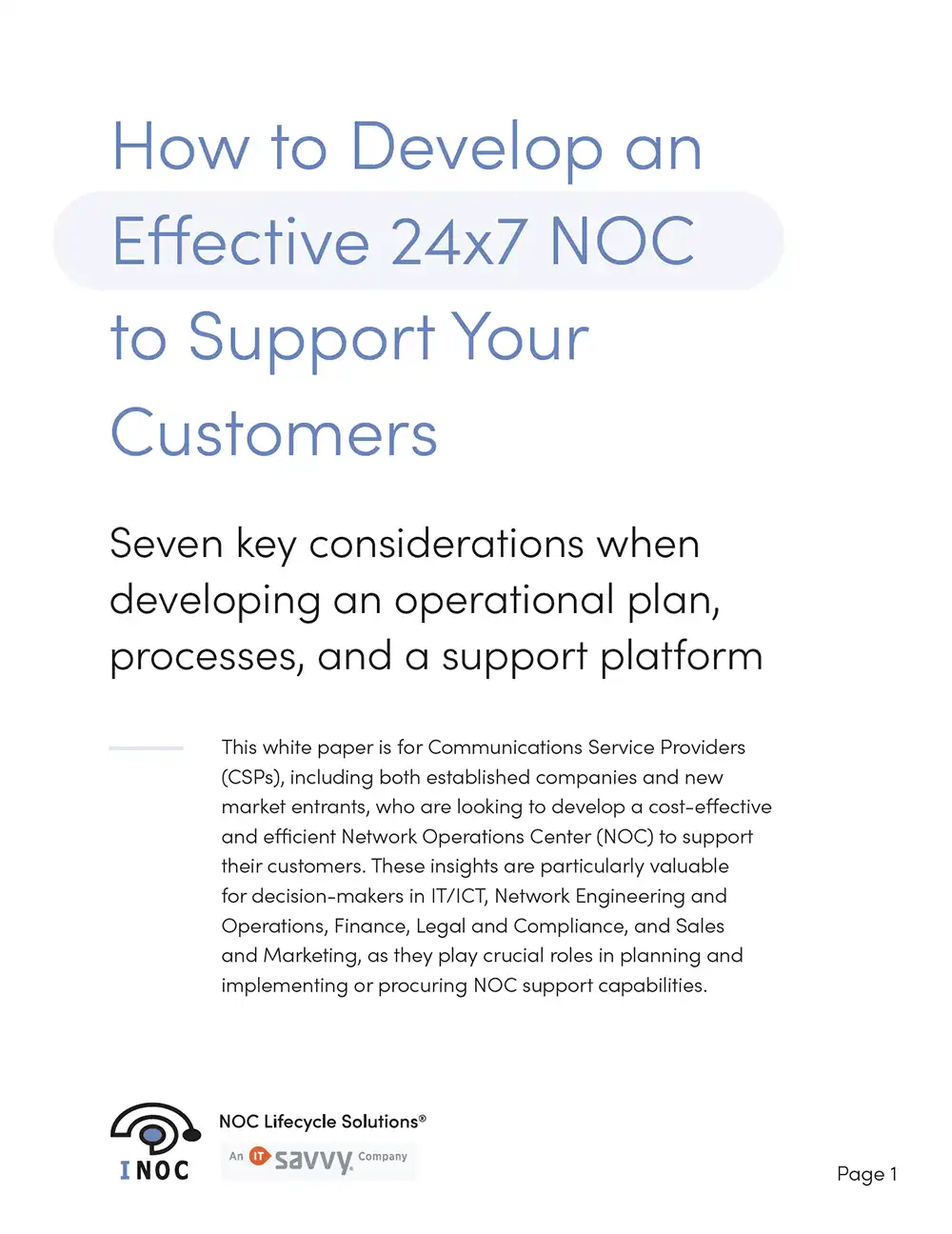

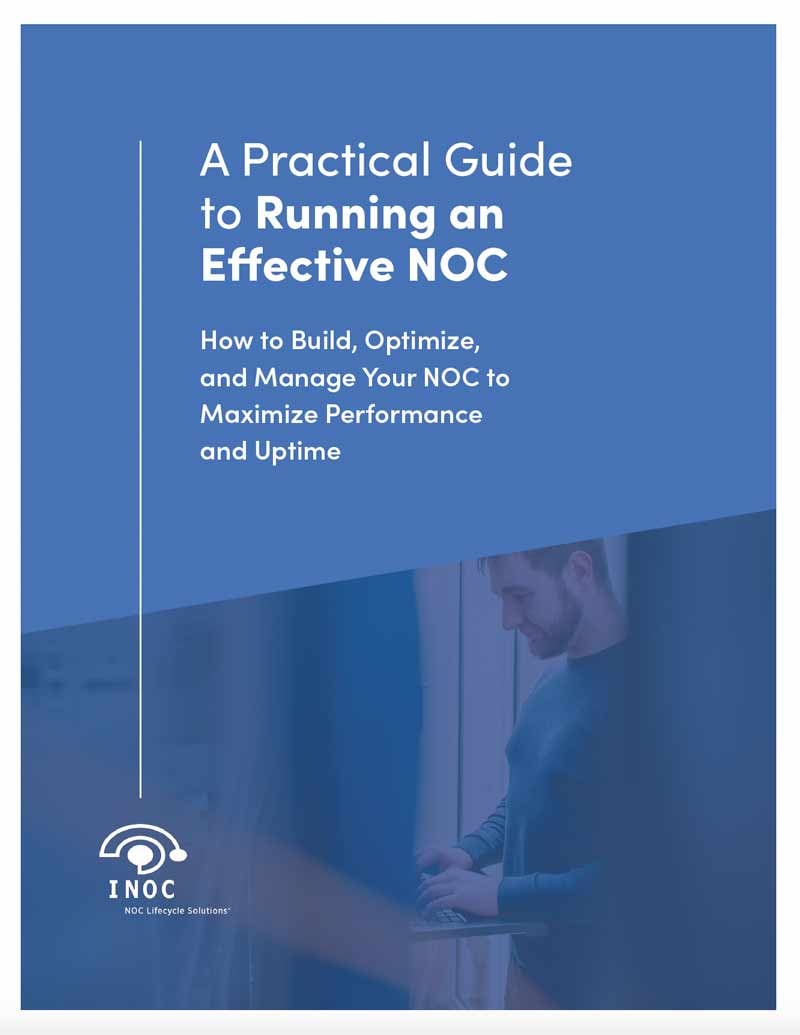
-images-0.jpg?height=2000&name=ino-WP-NOCPerformanceMetrics-01%20(1)-images-0.jpg)

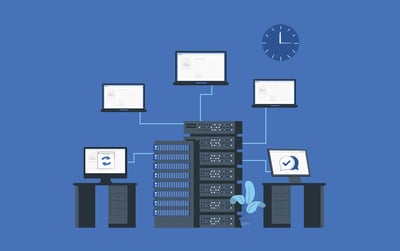

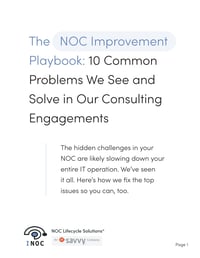

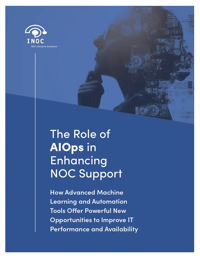

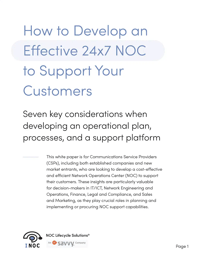
-images-0.jpg?width=200&height=259&name=ino-WP-NOCPerformanceMetrics-01%20(1)-images-0.jpg)